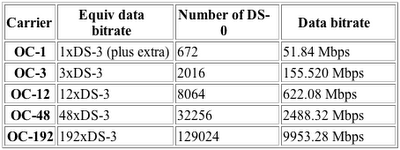So this is just a short tutorial, so I don’t have to repeat this to every person who asks about the difference between T and E circuits. Here is the whole thing (more or less), (hopefully) once and for all.
It all starts with the Nyquist’s Theorem and Pulse Code Modulation. PCM is the way telephones digitize audio (your voice). Nyquist’s Theorem (named after Harry Nyquist) says that “When sampling a signal, the sampling frequency must be greater than twice the bandwidth of the input signal in order to be able to reconstruct the original perfectly from the sampled version”. Another way of putting this is that to accuretly encode an analog signal (your voice) you have to sample it twice as often as the total bandwidth you wish to reproduce (your voice on the other side).
Now the phone system carries frequencies between 300-4000 Hz, so according to Nyquist, a sampling of 8000 samples per second will be enough to reproduce any frequency within the bandwidth of an analog phone.
Now fast forward past a bunch of engineering mombo-jumbo (keeping the 8000 samples/sec in mind) and we get to DS-0, the magic designation of the foundation of digital communications. You see the standard way of to digitize a phone call is to record (transmit) an 8-bit sample 8000 times/sec. This PCM encoded stream requires a bandwidth of 64,000 bps. This 64-kbps channel is known as DS-0 and is the foundation of all digital telecommunication circuits.
So now that we have our base unit (DS-0) lets look at one level higher, the T-carrier circuits. You’ve probably heard of a T-1 line, right? Well a T-1 line is actually 24 DS-0 lines multiplexed into a 1.54 Mbps line. The proper definition of a T-1 line is actually DS-1. Now for your trivia question…..what’s a E-1? Well it’s similar in concept to a T-1 except the Europeans actually used 32 DS-0s to define E-1 (rather than 24 like in North America). BTW the really confusing part is that an E-1 — despite having 32 channels rather than 24 — is also called DS-1…..go figure. Usually T-3 is the max and it’s pretty uncommon to find higher T-carrier circuits (ie: T-4, 5’s). That’s where Optical Carriers (aka OC) come in. The SONET (Synchronous Optical Networks) were developed to push the T-carrier systems to the next level (ie: Fiber). SONETs are based on the bandwidth of a T-3 line (44.736). Actually the are exactly 51.84 Mbps, the difference being attributed to overhead. This is what they call OC-1 or STS-1 which is the basic unit of measure here.
Usually T-3 is the max and it’s pretty uncommon to find higher T-carrier circuits (ie: T-4, 5’s). That’s where Optical Carriers (aka OC) come in. The SONET (Synchronous Optical Networks) were developed to push the T-carrier systems to the next level (ie: Fiber). SONETs are based on the bandwidth of a T-3 line (44.736). Actually the are exactly 51.84 Mbps, the difference being attributed to overhead. This is what they call OC-1 or STS-1 which is the basic unit of measure here. So now you know all there is to know about the telecomm buzzwords, but please keep in mind that the industry is changing and as we speak Dense Wave Division Multiplexing (DWDM) schemes are jepourdising the future of the above technologies (anyone remember ATM?)
So now you know all there is to know about the telecomm buzzwords, but please keep in mind that the industry is changing and as we speak Dense Wave Division Multiplexing (DWDM) schemes are jepourdising the future of the above technologies (anyone remember ATM?)